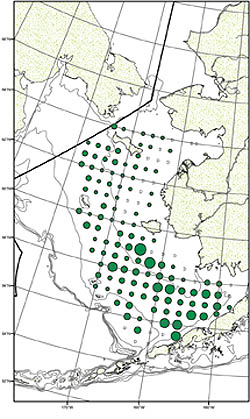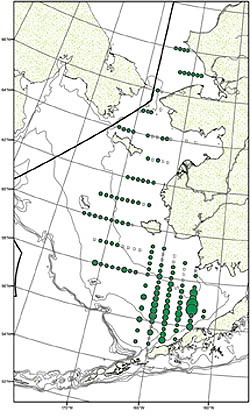Ocean Carrying Capacity Program
Age-0 Pollock Distribution in the Eastern Bering Sea
The Ocean Carrying Capacity (OCC) program conducted its annual Bering Aleutian Salmon International
Survey (BASIS) from 14 August to 30 September 2004. The objectives of BASIS are to identify the physical
and biological mechanisms that affect the migration, distribution, and early life history of Pacific
salmon and other commercially important species in the Bering Sea.
Of these species, walleye pollock is one of the most abundant pelagic fish in the Bering Sea. Besides
being one of the largest fisheries resources in the world, pollock are important prey to marine mammals,
seabirds, and piscivorous fishes. Because of walleye pollock’s commercial importance, OCC scientists have
assessed the distribution and abundance of age-0 pollock in the eastern Bering Sea during BASIS cruises.
Age-0 pollock distribution and CPUE during the 2004 (Fig. 1) and 2003
(Fig. 2) BASIS research cruises in the eastern Bering Sea.
|
|
 |

Figure 1. 14 August–30 September 2004.
|
|

Figure 2. 21 August–8 October 2003.
|
During the 2004 cruise, a total of 2.6 million individual age-0 pollock were caught at 143 stations.
Age-0 pollock were distributed throughout the eastern Bering Sea from lat. 55°30'N to lat. 64°N. The
greatest catch per unit effort (CPUE) of pollock occurred at stations along the 50-m contour line within
Bristol Bay and north to lat. 59°N (Fig. 1 above). Total catch in 2004 increased by 50% from 2003, when
1.3 million age-0 pollock were caught at 151 stations. Pollock distribution differed between 2003 and 2004,
with the greatest CPUE of pollock in 2003 occurring in the middle domain (between 50 and 100 m) on the
longitude 162°W transect (Fig. 2 above).
A variety of factors influence pollock distribution and abundance. Wind and current patterns, competition, prey
availability, and predation all play a critical role in pollock distribution and biomass. Future OCC studies will
look for relationships between prey availability, oceanographic conditions, and age-0 pollock diet and energy density.
By Angela Middleton
ABL Weather Station
The year 2004 in southeastern Alaska began with an exceptionally mild winter quarter (January– March) with
above average air temperatures and below average snowfall. The spring quarter (April– June) continued this
trend with record high air temperatures in May and June and record low rainfall in June. These unusual
conditions may influence future salmon harvests in southeastern Alaska. The high temperatures resulted in
record high stream and lake temperatures approaching and (in some cases) exceeding 20°C, stressing juvenile
fishes rearing in low-elevation streams. Additionally, the low spring snowpack and low rainfall resulted in
some small streams with water flows too low for early returning salmon to enter the streams. July frequently
has cooler weather and more rainfall than June, and the continuing warming trend was not beneficial to salmon
returning to spawning streams in July and August. Sufficient rain to raise stream flows was not seen until
mid-September, much too late for most of the pink salmon and early chum salmon runs.
The abnormally high sea surface temperatures reported from Auke Bay were also evident in the oceanic areas of
the Gulf of Alaska. Through most of the summer, the sea surface temperatures were 1°–2° C above the climatic mean.
This not only reflects unusually warm air temperatures over the Gulf of Alaska, but also the transport of warmer
than average waters from the south by the Alaskan Gyre. Possibly associated with these warm water conditions was
the finding of a Pacific Ridley turtle (Lepidochelys olivacea) carcass near Yakutat, Alaska, and the
sightings of white sharks (Carcharodon carcharias) off Noyes Island in August and Yakutat in September.
Also, two thresher sharks (Alopias vulpinus) were caught by salmon fishermen in southeastern Alaska this
season. In September, a longliner caught two jumbo squid (Dosidicus gigas) off the Fairweather Grounds
between Sitka and Yakutat. Jumbo squid are rarely seen as far north as San Diego, California, but in 2004 the
species was reported also off the Washington coast.
By Bruce Wing
>>>continued

|

|
Quarterly sidebar
AFSC Quarterly Research Reports July-Sept 2004
Contents
Feature
ABL Reports
NMML Reports
RACE Reports
REFM Reports
Quarterly Index
Quarterly Home
|

